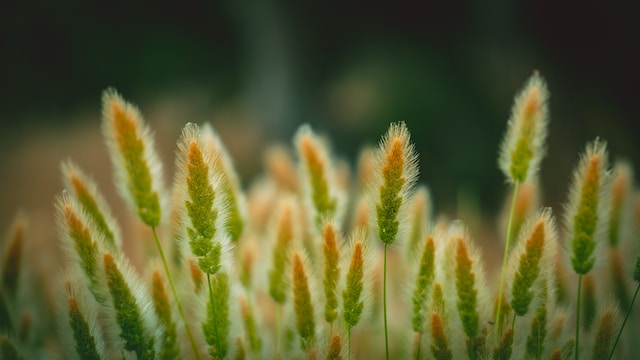Why Is Grass Seed So Expensive?
A beautiful lawn can be a source of pride for any homeowner, and growing grass from seed is an affordable way to achieve that. However, those who have bought grass seed recently may have noticed that the price of grass seed has gone up significantly in recent years. So why is grass seed so expensive?
The cost of grass seed can vary depending on the type of seed you choose and the region of the United States you are in. However, in general, you can expect to pay anywhere from a few cents to several dollars per square foot of grass seed. The price of grass seed can depend on several factors, such as the type of seed, the quality of the seed, and the demand for that particular type of seed.
One of the biggest factors in the cost of grass seed is the type of grass you choose. There are many different types of grass, each with its strengths and weaknesses. For example, Kentucky bluegrass is a popular choice for those who want a lush, green lawn, but it can be expensive. On the other hand, tall fescue is a more affordable option, but it may not provide the same level of aesthetic appeal.
Another factor that affects the price of grass seed is the ongoing research and development needed to produce high-quality grass seed that grows well in different regions and under different conditions. This research is often conducted by universities and private companies, and it requires significant financial investment. This investment is then reflected in the price of the seed.
Additionally, the cost of producing grass seed continues to rise due to factors such as labor, transportation, and raw materials. These costs are then passed on to consumers in the form of higher prices.
It is worth noting that the cost of grass seed can be reduced by taking good care of your lawn. By properly caring for your lawn, you can help your grass seed grow and thrive, which can reduce the need to purchase more seeds in the future. Proper lawn care includes practices such as mowing at the right height, watering at the right time and amount, and fertilizing as needed.
In summary, the cost of grass seed depends on several factors, including the type of seed, the quality of the seed, ongoing research and development, and production costs. While the price of grass seed can be expensive, taking good care of your lawn can help reduce the need for additional seed in the future. Ultimately, the investment in a beautiful lawn is worth it for many homeowners, and the cost of grass seed is just one part of that investment.
Frequently Asked Questions
How to plant grass seed?
Planting grass seeds can be a relatively simple process if you follow a few basic steps. Here’s a step-by-step guide:
1. Prepare the soil: First, remove any weeds, debris, or rocks from the area where you want to plant the grass seed. Then, loosen the soil using a rake or tiller. The soil should be crumbly, and the topsoil should be at least 2-4 inches deep.
2. Choose the right grass seed: Select the type of grass seed that will thrive in your region and climate. For instance, if you live in a warm region, Bermuda grass or Zoysia grass may be the best choice. If you live in a cool region, you may want to consider Kentucky bluegrass or fescue.
3. Spread the seed: Use a seed spreader to distribute the grass seed evenly across the soil. Be sure to follow the instructions on the seed bag regarding how much seed to use per square foot.
4. Cover the seed: After spreading the seed, use a rake or a drag to gently cover the seed with a thin layer of soil. This will help protect the seed from birds and other animals and will also help keep it moist.
5. Water the area: Water the area thoroughly but gently to ensure the seed stays in place. Keep the soil moist by watering lightly each day until the seedlings begin to emerge. Then, gradually reduce the amount of water you use.
6. Fertilize the grass: Once the grass is established, it’s important to fertilize it to keep it healthy and green. Follow the instructions on the fertilizer bag and apply it at the appropriate time of year.
7. Mow the grass: When the grass is about 3-4 inches tall, it’s time to mow it for the first time. Be sure to set the mower blade high to avoid cutting the grass too short.
By following these steps, you can successfully plant and grow a beautiful lawn from grass seed.
How long does it take for grass seed to grow?
The time it takes for grass seed to grow depends on several factors, including the type of grass, weather conditions, soil quality, and proper care. Generally, it can take anywhere from 5 days to 30 days for grass seeds to germinate and start growing.
Cool-season grasses such as Kentucky bluegrass and perennial ryegrass typically take around 7-21 days to germinate, while warm-season grasses like Bermuda grass and zoysia grass can take 10-30 days or more.
During the germination period, it is important to keep the soil consistently moist, but not saturated, to ensure the best conditions for growth. Once the grass has started growing, it will continue to develop over several weeks and months, depending on the variety.
It is important to continue to care for the grass by providing adequate water, fertilization, and mowing, to ensure a healthy and beautiful lawn.
When to plant grass seed?
The best time to plant grass seed depends on the climate and the type of grass you want to grow. Generally, it is recommended to plant cool-season grasses, such as Kentucky bluegrass, ryegrass, and fescues, in the fall or early spring when the soil temperature is between 50 and 65 degrees Fahrenheit. Warm-season grasses, such as Bermuda grass and Zoysia grass, are best planted in the late spring or early summer when the soil temperature is above 60 degrees Fahrenheit.
It is important to check the climate and soil conditions in your area and consult with local gardening experts or lawn care professionals to determine the best time to plant grass seed for optimal growth and health.
When is the best time to plant grass seed?
The best time to plant grass seed depends on the type of grass you plan to grow and the climate in your region. In general, the ideal time to plant grass seed is during the cooler months of the year, when temperatures are between 60 and 75 degrees Fahrenheit and there is sufficient moisture for seed germination.
For cool-season grasses like Kentucky bluegrass, fescue, and ryegrass, the best time to plant grass seed is in the early fall or spring, when the soil is moist and temperatures are cool. This allows the grass to establish a strong root system before the heat of summer arrives.
For warm-season grasses like Bermuda grass, zoysia grass, and centipede grass, the best time to plant grass seed is in late spring or early summer, when the soil is warm and there is plenty of sunlight for growth.
It’s important to note that the timing for planting grass seeds can vary depending on your specific location and climate, so it’s a good idea to check with your local nursery or lawn care professional for guidance.
How much grass seed do I need?
The amount of grass seed you need depends on several factors, including the size of the area you want to cover, the type of grass seed you choose, and the recommended seeding rate for that type of grass. In general, you should aim to use about 2 to 3 pounds of grass seed per 1,000 square feet of lawn area.
To calculate the amount of grass seed you need, first, determine the square footage of your lawn area by measuring its length and width and multiplying these values together. Then, divide this number by 1,000 to get the number of thousands of square feet in your lawn area. Finally, multiply this number by the recommended seeding rate for the type of grass you choose, usually expressed in pounds per 1,000 square feet.
For example, if your lawn area is 5,000 square feet and you want to plant Kentucky bluegrass, which has a recommended seeding rate of 2 to 3 pounds per 1,000 square feet, you would need 10 to 15 pounds of grass seed (5 x 2 = 10 or 5 x 3 = 15).
It’s important to note that using too little grass seed can result in a thin, patchy lawn while using too much can lead to overcrowding and competition for resources among the grass plants. Therefore, it’s important to follow the recommended seeding rate for the type of grass you choose to ensure optimal growth and coverage.
How often to water new grass seed?
Watering is crucial for the successful growth of new grass seeds. After planting, it is important to keep the top inch of soil moist until the seed germinates, which typically takes 7 to 21 days depending on the grass variety and weather conditions. Here are some guidelines on how often to water new grass seed:
1. Frequency: Water the seeded area lightly and frequently, 2 to 3 times a day, to keep the soil consistently moist but not waterlogged. Avoid letting the soil dry out or become too saturated.
2. Duration: Each watering session should be brief, about 5 to 10 minutes, so as not to wash away the seeds or drown the young sprouts. Use a gentle spray or sprinkler to evenly distribute water.
3. Soil type: The type of soil you have will affect the frequency and duration of watering. Sandy soil drains quickly and may require more frequent watering, while clay soil retains moisture longer and may require less frequent watering.
4. Weather conditions: Adjust your watering schedule according to the weather. During hot and dry periods, you may need to water more often, while during cooler and rainy periods, you may need to water less.
5. After germination: Once the grass seed has germinated and the seedlings have established a root system, reduce the frequency of watering to once a day or every other day, but increase the amount of water per session.
By following these watering guidelines, you can help ensure the success of your new grass seed and promote the growth of a lush, healthy lawn.
How long does it take for a grass seed to germinate?
The time it takes for grass seed to germinate depends on several factors, including the type of grass, temperature, moisture, and soil conditions. In general, most grass seeds will start to germinate within 5 to 30 days after planting. However, some types of grasses, such as ryegrass and tall fescue, may germinate in as little as 3 to 5 days under ideal conditions.
To ensure optimal germination, it’s important to follow the instructions on the grass seed package and provide the seed with proper care. This includes planting the seed at the correct depth, watering it regularly and consistently, and keeping the soil moist but not waterlogged. Providing the seed with adequate sunlight and warmth will also help to encourage faster germination.
Once the grass seed has germinated, it will continue to grow and develop over time with proper care and maintenance. This includes regular watering, fertilization, and mowing as needed to promote healthy growth and a lush, green lawn.
How long does grass seed last?
The shelf life of grass seed can vary depending on several factors, including the type of grass seed, how it is stored, and the conditions it is exposed to. In general, most grass seeds can last for up to two to three years if stored in a cool, dry, and dark place.
However, it is important to note that the germination rate of the seed will decrease over time. The older the seed, the lower the germination rate, and the longer it may take for the grass to establish. If you are using old grass seed, you may need to plant more seed to ensure adequate coverage.
To get the most out of your grass seed, it is best to use it as soon as possible after purchasing it. Be sure to store any leftover seed in a cool, dry, and dark place to extend its shelf life.
When to stop watering new grass seed?
Once the grass seed has germinated and the new grass has grown to a height of 2-3 inches, you can gradually reduce the frequency of watering. This typically occurs about 4-6 weeks after planting, depending on the type of grass and the local weather conditions. It’s important to continue watering deeply and infrequently until the roots are established, which can take up to a year. Once the grass is established, you can transition to a regular watering schedule based on the needs of the specific grass species and your local climate.
How to plant grass seed on hard dirt?
Planting grass seed on hard dirt can be a challenge, but with some preparation and the right techniques, it is possible to achieve a beautiful lawn. Here are the steps to follow to plant grass seed on hard dirt:
1. Prepare the soil: Start by loosening the soil with a garden fork or tiller to a depth of at least 2-3 inches. Remove any rocks or debris and level the soil using a rake. If the soil is very hard, consider adding a layer of topsoil or compost to improve its quality and texture.
2. Choose the right seed: Select a grass seed that is suitable for your region and soil type. Some grasses are better adapted to hot and dry climates, while others prefer cooler temperatures and more moisture. Look for a seed mix that contains a variety of grass types, as this will provide greater resistance to pests, diseases, and environmental stresses.
3. Sow the seed: Use a spreader or your hands to distribute the seed evenly over the prepared soil. The recommended rate is typically one pound of seed per 250-300 square feet. Cover the seed with a light layer of soil or compost, no more than 1/4 inch deep.
4. Water regularly: Keep the soil moist by watering lightly and frequently, two to three times a day for the first two weeks. Once the grass starts to grow, reduce the frequency of watering but increase the amount of water to encourage deeper root growth. Water in the early morning or late afternoon to minimize evaporation and fungal growth.
5. Provide proper care: Once the grass is established, continue to care for it by mowing regularly, fertilizing it as needed, and controlling weeds and pests. Avoid heavy foot traffic until the grass is well established, usually after the first growing season.
By following these steps, you can successfully plant grass seeds on hard dirt and enjoy a lush, green lawn for years to come.
How long is grass seed good for?
Grass seeds can last for several years if stored properly. The key to preserving the quality of grass seed is to store it in a cool, dry place, such as a garage or basement, and away from direct sunlight. Properly stored grass seed can remain viable for up to five years or more, depending on the type of seed and the conditions in which it is stored.
It’s important to note that even though grass seed may still be technically “good” after several years, the germination rate may decrease over time. This means that the seed may take longer to sprout or may produce fewer viable plants. For best results, it’s recommended to use fresh grass seed whenever possible.
To test the viability of older grass seeds, you can perform a simple germination test. Take a small sample of the seed and place it on a damp paper towel. Keep the towel moist and in a warm, dark place for several days. After a few days, check the seed for signs of germination. If a significant portion of the seed has sprouted, the seed is likely still viable. However, if only a few seeds have sprouted, it may be best to purchase fresh seeds for optimal results.
How long for grass seed to sprout?
Typically, it takes 5 to 10 days for grass seed to sprout, but the actual time frame may vary depending on factors such as the type of grass, soil temperature, moisture, and other environmental conditions. Some types of grass, such as Kentucky bluegrass, can take longer to germinate, while others like ryegrass can germinate in as little as 3 to 5 days. It’s essential to ensure that the soil stays moist during this period, as the lack of moisture can significantly delay the sprouting process.













